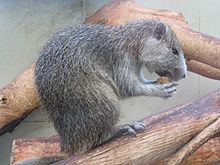Loading AI tools
Rodents of the subfamily Capromyinae From Wikipedia, the free encyclopedia
Hutias (known in Spanish as jutía[1]) are moderately large cavy-like rodents of the subfamily Capromyinae that inhabit the Caribbean islands. Most species are restricted to Cuba, but species are known from all of the Greater Antilles, as well as The Bahamas and (formerly) Little Swan Island off of Honduras.
| Hutia Temporal range: | |
|---|---|
 | |
| Desmarest's hutia (Capromys pilorides) | |
| Scientific classification | |
| Domain: | Eukaryota |
| Kingdom: | Animalia |
| Phylum: | Chordata |
| Class: | Mammalia |
| Order: | Rodentia |
| Family: | Echimyidae |
| Subfamily: | Capromyinae Smith, 1842 |
| Type genus | |
| Capromys Desmarest, 1822 | |
| Genera | |
|
Tribe Capromyini Tribe Plagiodontini †Tribe Hexolobodontini †Tribe Isolobodontini | |
Twenty species of hutia have been identified, but at least half are extinct. Only Desmarest's hutia and the prehensile-tailed hutia remain common and widespread; all other extant species are considered threatened by the IUCN.
The extinct giant hutias of the family Heptaxodontidae also inhabited the Caribbean, but are not thought to be closely related, with the giant hutias belonging in the superfamily Chinchilloidea.[2]
Most species have a head-and-body length that ranges from 21 to 46 cm (8.3 to 18.1 in) and weigh less than 2 kg (4.4 lb), but Desmarest's hutia has a head-and-body length of 31 to 60 cm (12 to 24 in) and weighs 2.8–8.5 kg (6.2–18.7 lb).[3] They resemble the coypu in some respects. Tails are present, varying from vestiges to prehensile. They have stout bodies and large heads. Most species are herbivorous, though some consume small animals. Instead of burrowing underground, they nest in trees or rock crevices.
They are hunted for food in Cuba, where they are often cooked in a large pot with wild nuts and honey. At the Guantanamo Bay Naval Base however, there is an over population due to an abundant food source and the lack of natural predators. Desmarest's hutias are referred to by those stationed at the Guantanamo Bay Naval Base as banana rats.[4] Banana rats are not named for their dietary preference, but because their feces look like small versions of the fruit. They are known to come out at night.
Molecular studies of phylogeny indicate that hutias nest within the Neotropical spiny rats (Echimyidae).[5] Indeed, the hutia subfamily, Capromyinae, is the sister group to Owl's spiny rat Carterodon.[6] In turn, this clade shares phylogenetic affinities with a subfamily of spiny rats, the Euryzygomatomyinae.[6]
Within Capromyidae, the deepest split involves Plagiodontia with respect to other genera, followed by the divergence of Geocapromys. The latter genus is the sister group to a clade in which Capromys branches off before the Mesocapromys and Mysateles split.
| Genus-level cladogram of the Capromyidae with their relationship to Carterodon and Euryzygomatomyinae. | ||
|
| ||
| The cladogram has been reconstructed from mitochondrial and nuclear DNA characters.[7][8][9][5][10][6] |
Hutias colonized the islands of the Caribbean as far as the Bahamas by Oceanic dispersal from South America,[11][12] reaching the Greater Antilles by the early Oligocene.[13] This was facilitated by the direction of prevailing currents.

The systematics of the 10 extant and 11 extinct recognized species of Capromyidae is as follows.[14][15][16] Taxa known to be extinct are marked with a dagger (†).
Seamless Wikipedia browsing. On steroids.
Every time you click a link to Wikipedia, Wiktionary or Wikiquote in your browser's search results, it will show the modern Wikiwand interface.
Wikiwand extension is a five stars, simple, with minimum permission required to keep your browsing private, safe and transparent.